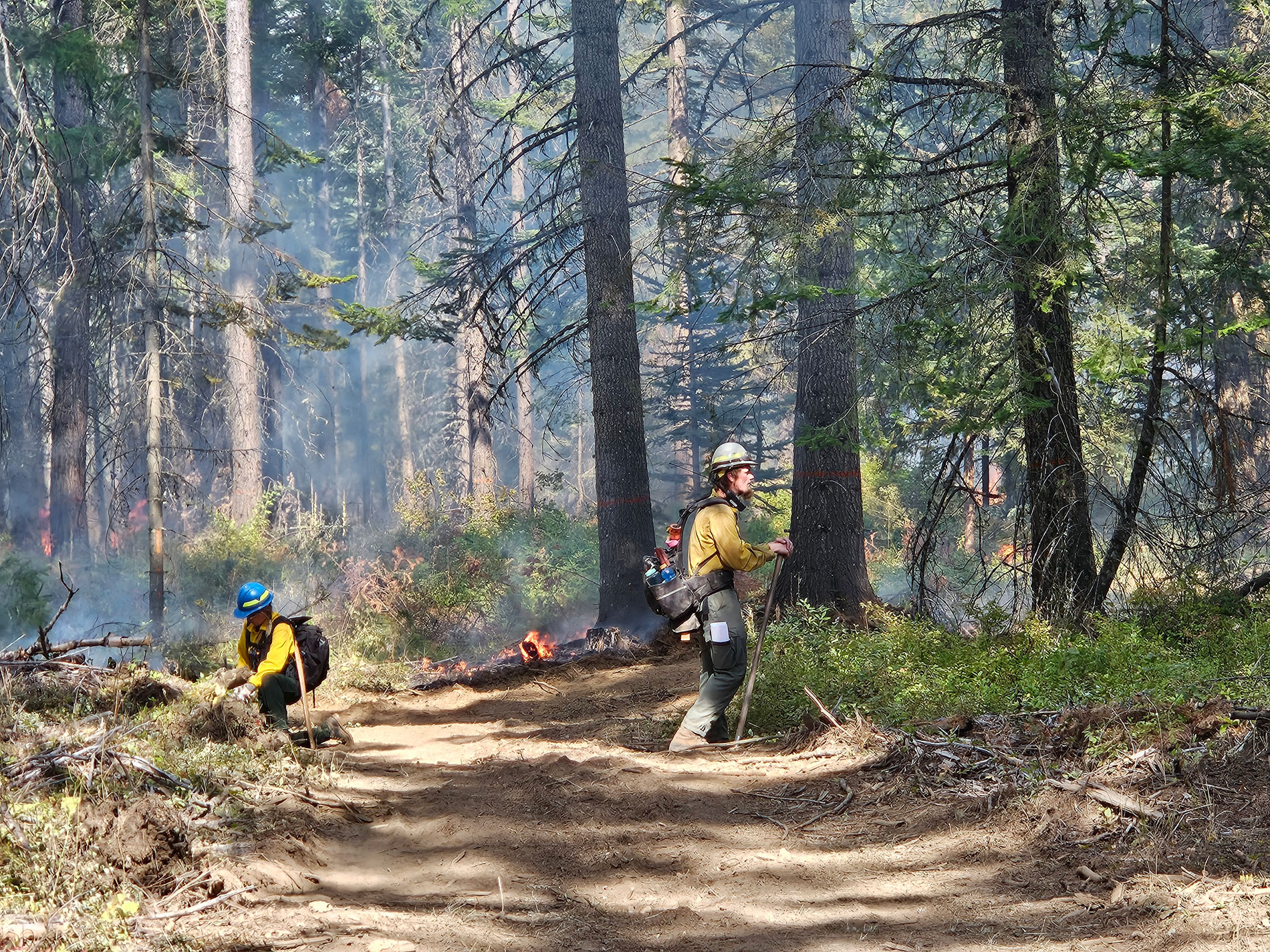
Prescribed fires help manage forests in the Northwest
Listen
(Runtime 4:22)
Read
Trucks line an unpaved road about 50 minutes up Robinette Mountain Road near Dayton, Washington. Crews are ready to burn over 37 acres at the Rainwater Wildlife Area.
As wildfire season winds down, crews around Washington and Oregon perform prescribed fires.
Lindsay Chiono is a wildlife habitat ecologist with the Confederated Tribes of the Umatilla Indian Reservation. During this burn, she’s also the firing boss. That means she’s guiding the lighters — the people setting the fire.
“We’ve tried to burn this unit for three years in a row. Just a few weeks ago was summer, and high fire hazard. So it’s a small window up this high elevation,” she said.
Chiono and 22 members from tribal, governmental and private organizations performed the prescribed fire on the tribe’s lands in late September.
Prescribed fires can also help mitigate future wildfires and ecosystem resilience.
Jeremy Alford is with The Nature Conservancy and is part of a dedicated prescribed fire crew working across the Umatilla and Wallowa-Whitman National Forests.
“In all our western forests, fire is just as important as rain and other weather stuff. It’s just like a part of the environment, and it gets destructive when we stop too much fire and don’t let fire actually go clean up the forest,” Alford said.
At the starting point, the lighters ignite areas under Chiono’s direction. They are testing whether there are good conditions for burning.
“It’s looking like … they are going to go forward,” Radcliffe said.
That’s Kaci Radcliffe, a forest restoration project manager with The Nature Conservancy. She said lighters follow a pattern in the field, like following a line.
“She can change the pattern and the instructions so that even if the wind or the temperature changes, we can keep burning today,” Radcliffe said.
As they move forward, Chiono evaluates the fire behavior.
Chiono describes the fire as “pretty patchy” and slow going, adding that she’d hoped the fire would carry better.
“But it may pick up as the winds pick up today,” she said.
Another team member, John Punches, looks on closely. He’s an associate professor in the Department of Forest Engineering, Resources and Management at Oregon State University.
Punches monitors the fire’s effects.
“What’s burning out are the places where there’s accumulated branches and needles from the logging operation. We call that the ‘slash.’ That’s what’s actually carrying the fire,” Punches explained.
He says the goal is to consume 60% of the active fuels present in the forest. Controlling those fuels could prevent future wildfires.
Punches and two trainees observe the conditions.
“Every hour, we collect the weather and we report that over the radio, so that all the people here who are doing the job of firing, putting fire on the ground, or holding — keeping the fire inside the fire lines — they have that current weather assessment,” he said.

A team member waters certain areas consumed by fire during a prescribed fire in the Rainwater Wildlife Area. This is part of the process to ensure the flames are under control. (Credit: Johanna Bejarano / NWPB)
A change in weather conditions can drastically change a prescribed fire.
This happened recently with the Tiger Creek Fire in the Walla Walla Ranger District of the Umatilla National Forest.
According to a press release, the U.S. Forest Service said they initiated a planned 335-acre prescribed fire on Sept. 30. However, during the operations, “a local weather shift caused winds which enabled the fire to go beyond the planned perimeter.”
According to Inciweb, at the time of publication, the Tiger Creek Fire is has burned 534 acres and is 89% contained.
Jeff Casey is the Rainwater’s fire burn boss. A fire burn boss oversees the entire operations during a prescribed fire. Late in September, he says most prescribed fires do not go wrong.
“For every bad fire in the United States, there are probably a hundred good fires,” he said.

A member of the team monitors the area outside the controlled fire boundary. (Credit: Johanna Bejarano / NWPB)
Jerry Middel is a project lead for the Rainwater Wildlife Area.
Middel explained that in 1998, the Confederated Tribes of the Umatilla Indian Reservation bought 8,500 acres in the area. Over the next 20 years, they added another 2,500 acres. He said last year, it went from being tribal fee land to tribal trust lands.
Middel said that means it is now under the jurisdiction of the Bureau of Indian Affairs.
He said prescribed fires are one of their many actions to protect the wildlife area.
“Our job primarily is to restore and protect habitat,” Middel said. “There are 10 miles of anadromous fish streams, which means salmonid species, steelhead and bull trout are down there on the river. And then we have 8,500 acres of conifer forest, it is what you’re looking at here.”
Correction: This story has been updated to include Jeremy Alford’s correct job title.

















